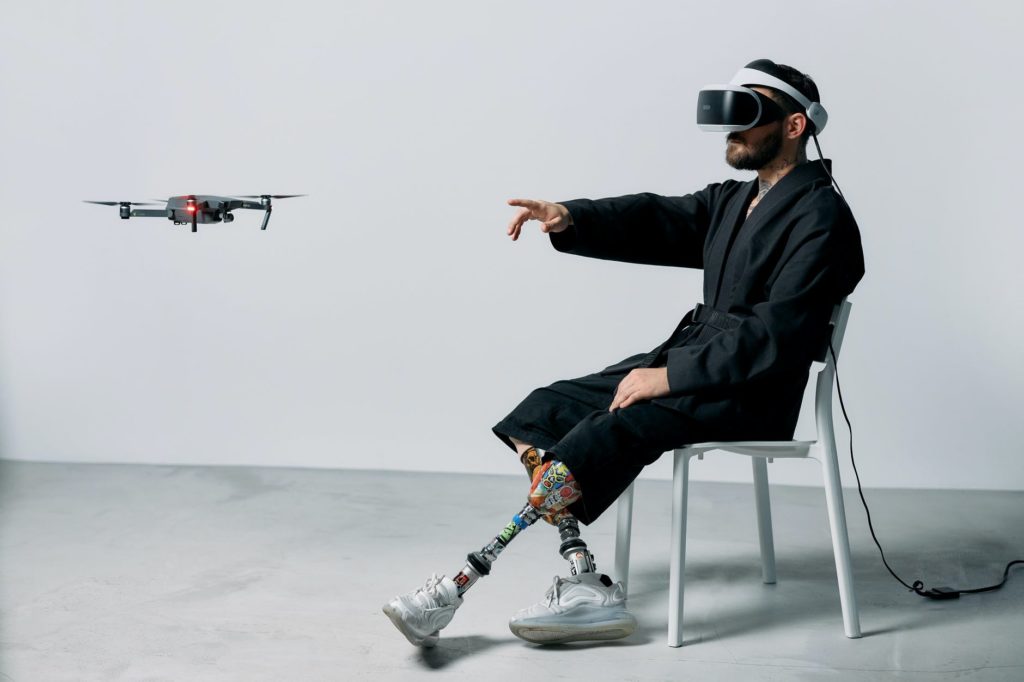What is Virtual Reality?
Virtual Reality uses computer technology and creates a simulated environment to give the users an experience. It immerses the users and helps them to interact with a 3D environment. It simulates a large number of senses including vision, touch, hearing, and smell.
Technologies like Virtual and Augmented reality have started creating a lot of traction among various industries. Many industries use it and for various tools.
It is thus the perfect time to learn to fulfill the frontend development of a website using these technologies. This will help you leap towards higher adoption levels.
Why is Virtual Reality Popular?
Virtual Reality is the latest technology that is making enormous changes in our way of living. It is changing the landscape of many industries from healthcare, gaming, and business to education.
The potential of virtual reality and augmented reality is huge when it comes to our lives and thus the investment in VR is going to be much higher in the coming years.
When we look through the designer’s lens, the ability to get into VR or AR is basically the same. As the passage for inconveniences in both these technologies is comparatively lower.
No matter whether you are a novice with little experience in programming or a specialist with long experience in the field, you have to have solid abilities to become a VR designer.
These abilities also include the 3D region. The advancement of the 3D game that is based on VR has made vivid conditions that can be interfaced within many measurements.
VR development should initially have creative and spatial thinking. Creating in 3D is based on mathematics and you are mainly required to think back.
Advancement in VR content is similar to 3D game improvement. This is also highly useful in the website designing space.
Let’s explore these VR and AR frameworks to create an environment in virtual reality within the frontend development ecosystem.
What are the uses and applications of VR?
Initially, the technology of Virtual reality was just a figment of the imagination but now it has started taking the shape of an actual device.
The users can put this device on their heads and immerse themselves into the living and breathing digital world. This has helped technology go to great heights and achieve much better results.

But unlike what people think, VR is not just limited to the gaming industry.
The current scope and applications of VR have increased widely from the automotive industry in which the engineers easily experiment with their prototype look to the healthcare industry where you can use it for the treatment of health issues.
Tourism industry and architects also use it. Wherever you look, the VR technology will be able to make its presence felt.
The current trends of virtual reality technology are going far and wide. We will break down certain frameworks which are currently available to the frontend developers who are looking to benefit from the VR atmosphere.
This will also include a look into the latest VR Frameworks that frontend developers can benefit from. Before that, let’s find out the types of virtual reality.
What are the types of Virtual Reality?
There are some major types of virtual reality as described below:
- Non-immersive VR – In this type of virtual reality, the users interact with the virtual environment through a computer to control characters within this experience.
- Fully Immersive VR – This is the opposite of non-immersive virtual reality and it ensures a realistic virtual experience. It uses special equipment like VR glasses and body detectors that are equipped with sense detectors.
- Semi-Immersive VR – This is something between non-immersive VR and fully immersive VR. It uses a system screen with VR glasses to roam around in a virtual environment but there is nothing else except a visual experience.
- Augmented Reality – This is a type of VR that lets the user see the real world through a screen and they can make virtual changes to this world.
- Collaborative VR – This type of virtual reality enables users to come together from different locations in a virtual environment usually as 3D projected characters.
Frontend Development and VR
VR is gaining ground and is now becoming a widely used technology. The development of applications using VR has now caught up on the web as well.
VR ecosystem has evolved like no other and the development frameworks that are VR-related bring these tools to your browser. Thus, the trend has picked up and is now gaining more ground.
The VR experts are now helping developers by creating string frameworks that will help them with frontend development.
Here we list the top VR frameworks that you can use in frontend development:
- WebXR or WebVR – This is a framework that is an open standard and lets the users experience augmented and mixed realities apart from virtual realities. The framework was first developed with VR in mind. With the evolution of AR and mixed realities, it transitioned to WebXR. The X here denotes any reality which can be used within a browser. The main goal of the open standard is it will detect the availability of XR capabilities, it will then query about the capabilities/ the framework will poll the XR device and display imagery on the XR device.
- ReactVR – Facebook developed VR through ReactVR and it uses the React ecosystem. This Framework has huge capabilities as it pairs WebGL with WebVR. It can create seamless and 360 experiences in the browser. The framework makes it easy to translate to VR devices. The ReactVR framework has now been pointed to the React360 framework. This is run by Facebook in the GitHub repository. This also suggests that the framework might move in a more exciting direction and help create even more seamless experiences.
- A-Frame – This was earlier a part of the Mozilla VR team and the idea behind creating it was to bring VR to frontend development. It was developed from a plain HTML file and it employed XML-like tags. The framework supports a huge range of VR devices. A-Frame is based on the top of HTML and this makes it simple to start with for a frontend developer. The core framework has been built on the top of three.js. This gives a composable, declarative, and reusable structure. It has access to DOM Apis, JavaScript, WebGL, and WebVR.
- PrimroseVR – This is an open-source and browser-based framework. You can easily use it to create great VR applications. The framework is based on JavaScript and uses WebGL for rendering. The users can form virtual VR meetings, virtual classrooms, and product showcase demos that are even compatible with Safari, Google Chrome, and Mozilla Firefox.
- BabylonJS – Being one of the most well-established and popular 3D model frameworks, BabylonJS is very popular. The latest update to the framework has been added to the support for WebXR. It has become a more powerful VR framework. The API of BabylonJS is extensive and its documentation is well done. This makes it extremely easy to start.
The online playground is great to experiment with codes and it also offers a sandbox for testing scenes, tools for shader creators, and exporters for the models that are made in 3DS.
Maya, Max, Unity 5, or Blender. It is an open render engine neatly packed in JavaScript. This also makes it one of the most popular frameworks for Front-end development.
Futuristic Technology
VR and AR devices are now becoming readily available to everyone and these frameworks are establishing new standards.
The expectations in the future will be to put a VR device for getting a 360-degree view of a place that you are planning to visit.
It will help to explore great locations in the browsers and convert a picture into immersive experiences. Virtual reality is slowly becoming part of general life.

There are many foundations in dealing with Virtual Reality development. The front-end developers need to learn the ways to use 3D video game engines. The designers should also have an option to import 3D resources.
This will help to populate the condition for which you are building. For example, 3D modeling tools like Maya and Blender or Google Poly’s online asset stores can be built using this technology.
Programmers should learn and program the in-game engine to design objects for interaction.
VR engineers have a lot of scopes when it comes to imagining and building. They can consider building 360° photographs or recordings and can start by creating spatial thinking and imagination.
Many famous companies are using 3D space in a highly attractive manner to build a strong interaction.
This is also true for any front-end development company. They leverage VR technology to create immersive experiences in web designing.
How to initiate Front End Development with VR?
The first step is by working on the technical skills. For a VR developer, it is important to have a strong command of technical skills.
These skills range from the knowledge of programming language to the management of a VR tool.
They start by networking with VR developers and front-end developers and as per their experience in the respective field, they get an idea about the journey. There are many hacks that they use to survive.
The VR developers should also learn and operate VR tools and cross-platform game engines.
VR front-end developers should also have basic knowledge of programming languages like C#.
They should also try their hands on Google Daydream and Gear VR tools for the best experience and also for experiencing the VR journey.
This includes the various modules from the experience of Android app development and web development.
Knowing the VR Hardware
Apart from all the above-mentioned points, it is also important for frontend development service providers to have test units.
These help in checking the way these applications will work. They also help to understand which bugs should be fixed up.
Many companies go off their budget to experience something similar to what others develop.
To target the users of VR in frontend development, the developers should get a target premium VR user.
Many options are available for such technology including Oculus Rift and HTC Vive. After deciding the target platform along with associated hardware or the headset, you should also consider the computing requirements.
But to ensure Frontend development services with VR, you will have to invest some money in PC gaming to ensure the best of results.
Synopsis
The above listed are the basic attributes a developer needs to know for frontend development.
VR is increasingly gaining lots of traction and is the future technology. Hence its significance cannot be ignored by the industries and people at large.
All product and company names are trademarks™, registered® or copyright© trademarks of their respective holders. Use of them does not imply any affiliation with or endorsement by them.
 +91 79 4898 8801
+91 79 4898 8801 contact@atharvasystem.com
contact@atharvasystem.com Healthcare
Healthcare
 Insurance
Insurance
 Hospitality
Hospitality
 Marketing & Sales
Marketing & Sales
 Media
Media
 Real Estate
Real Estate
 Technology
Technology


















